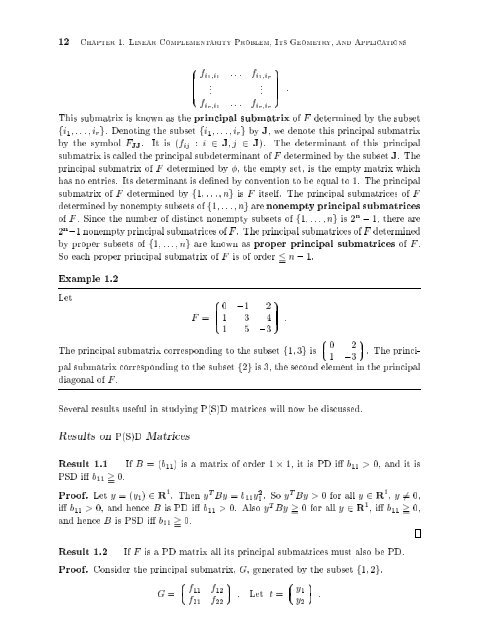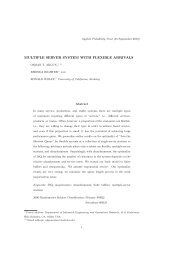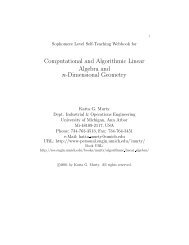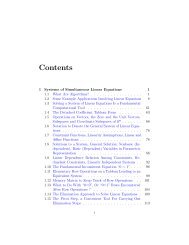Chapter 1 LINEAR COMPLEMENTARITY PROBLEM, ITS ...
Chapter 1 LINEAR COMPLEMENTARITY PROBLEM, ITS ...
Chapter 1 LINEAR COMPLEMENTARITY PROBLEM, ITS ...
Create successful ePaper yourself
Turn your PDF publications into a flip-book with our unique Google optimized e-Paper software.
12 <strong>Chapter</strong> 1. Linear Complementarity Problem, Its Geometry, and Applications<br />
8<br />
>:<br />
fi1i1 ::: fi1ir<br />
.<br />
firi1 ::: firir<br />
This submatrix is known as the principal submatrix of F determined by the subset<br />
fi1:::irg. Denoting the subset fi1:::irg by J, we denote this principal submatrix<br />
by the symbol FJJ. It is (fij : i 2 Jj 2 J). The determinant of this principal<br />
submatrix is called the principal subdeterminant ofF determined by the subset J. The<br />
principal submatrix of F determined by , the empty set, is the empty matrix which<br />
has no entries. Its determinant is de ned by convention to be equal to 1. The principal<br />
submatrix of F determined by f1:::ng is F itself. The principal submatrices of F<br />
determined by nonempty subsets of f1:::ng are nonempty principal submatrices<br />
of F . Since the number of distinct nonempty subsets of f1:::ng is 2n ; 1, there are<br />
2n ;1 nonempty principal submatrices of F . The principal submatrices of F determined<br />
by proper subsets of f1:::ng are known as proper principal submatrices of F .<br />
So each proper principal submatrix of F is of order <<br />
=<br />
n ; 1.<br />
Example 1.2<br />
Let<br />
F =<br />
8<br />
>:<br />
..<br />
9<br />
> :<br />
9<br />
0 ;1 2<br />
1 3 4><br />
1 5 ;3<br />
:<br />
0 2<br />
The principal submatrix corresponding to the subset f1 3g is >. The princi-<br />
1 ;3<br />
pal submatrix corresponding to the subset f2g is 3, the second element in the principal<br />
diagonal of F .<br />
Several results useful in studying P(S)D matrices will now be discussed.<br />
Results on P(S)D Matrices<br />
Result 1.1 If B = (b11) is a matrix of order 1 1, it is PD i b11 > 0, and it is<br />
PSD i b11 > = 0.<br />
Proof. Let y =(y1) 2 R 1 . Then y T By = b11y 2 1 . So y T By > 0 for all y 2 R 1 , y 6= 0,<br />
i b11 > 0, and hence B is PD i b11 > 0. Also y T By > = 0 for all y 2 R 1 , i b11 > = 0,<br />
and hence B is PSD i b11 > = 0.<br />
Result 1.2 If F is a PD matrix all its principal submatrices must also be PD.<br />
Proof. Consider the principal submatrix, G, generated by the subset f1 2g.<br />
G =<br />
8<br />
>: f11 f12<br />
f21 f22<br />
9<br />
> : Let t =<br />
8<br />
>: y1<br />
y2<br />
9<br />
> :<br />
8<br />
>:<br />
9










